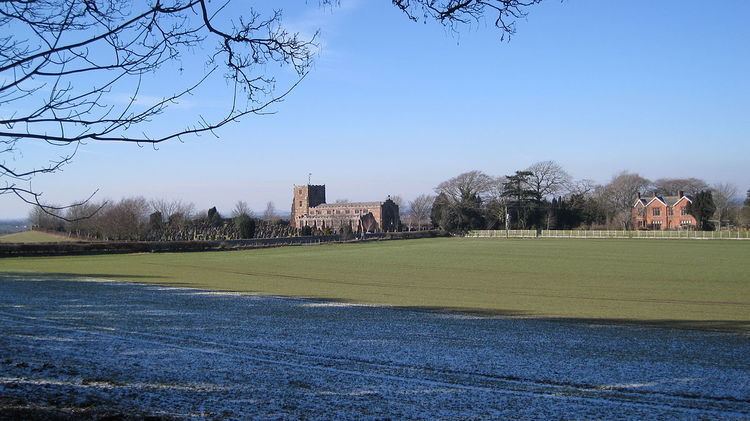Local time Saturday 2:00 PM | ||
 | ||
Weather 11°C, Wind SW at 34 km/h, 89% Humidity | ||
Arthuret is a civil parish in the Carlisle district of Cumbria, England. According to the 2001 census it had a population of 2,434, increasing to 2,471 at the 2011 Census. The parish includes the small town of Longtown and the village of Easton. It is bounded by the River Esk to the west and the River Lyne to the south.
Contents
Map of Arthuret, UK
Etymology
The interpretation of the name Arthuret has presented problems. The name can possibly be associated with the battle of Armterid recorded in the mid-10th century Welsh Annales Cambriae as having taken place in c. 573; Armterid (spelt Arfderydd in Modern Welsh) is composed of arm-, perhaps meaning "arms, weapon" (arf in Modern Welsh, borrowed ultimately from Latin arma, "arms, armour") – or perhaps an Old Welsh cognate of Old Irish airm meaning 'place' – and a second element terid "ardent, fierce; flaming, blazing; fast, nimble, swift" (terydd in Modern Welsh, a loan from Latin torridus, "scorched, parched, burned"). However, "...it seems safer to leave the interpretation of ' Armterid' an open question."
Arthurian Connections
The site of the church overlooks a suggested site of the Battle of Arfderydd, fought in 573 A.D., mention of which appears in Geoffrey of Monmouth's Vita Merlini and also in the Annales Cambriae (written c1100 A.D. where it appears as 'Bellum armterid'). The battle took place very early in the reign of the King of Strathclyde, Rhydderch Hael, (patron of St. Kentigern, and Myrddin's supposed brother-in-law), between the Warlord Gwenddoleu ap Ceidio and his cousins Peredur and Gwrgi, Princes of either Ebrauc (Modern York), or possibly from Gwynedd. In this battle, Gwenddoleu loses his life, and it is not known if one of his brothers, Nudd and Caw, survived to succeed him as king of Arfderydd afterwards.
In this battle Myrddin kills his nephew (by his sister Gwenddydd, wife of King Rhydderch Hael), who was fighting on the opposing side. This act drove Myrddin mad and he spent the rest of his life roaming the Forests of Celyddon (see) (Glennie 1869). 140 other men of rank suffered battle-madness and perished in these woods (Rich & Begg 1991).
In the Black Book of Carmarthen is recorded a poem which takes the form of a dialogue between Myrddin and the Welsh bard Taliesin (Skene 1988); it records how Myrddin wore a gold-torque and tells of his grief at the death of King Gwenddolau. The battle is said to have lasted six weeks and three hundred men were killed and buried nearby. It was one of the three futile battles of Britain, fought over a lark's nest.
Arthuret Church
The church tower stones are unusual in that many of them have masons' marks which are clearly visible. This church was built as a result of a national fundraising ordered by James I in 1607 because the existing church had been frequently devastated by Scots reivers/raiders and to benefit the parishioners who were mainly rejecting Christ's teachings. (James also employed more direct methods of improving the morals of the area, hanging notable reivers from both sides of the Border and deporting the Grahams of the Esk valley en masse to Ireland.) Part of the sum was stolen and this delayed the construction of the new church.
A holy well is located on the edge of the mound. It is a well-built structure, with stone canopy and steps. It was still used for baptisms until the 1970s.
Netherby Hall
Netherby Hall, the historic home of the Graham family, is a Grade II* listed mansion. It stands upon the site of the Roman fort of Castra Exploratorum. Its nucleus is a 15th-century pele tower, extended or altered in 1639 for Sir Richard Graham and enclosed by extensive later additions to the house (in the late 18th century), with further extensions taking place in 1833 for Sir James Graham l by William Burn. The original pele tower is thought to have been built with stone from the fort and the remains of the fort and its vicus noted by Tudor antiquarians have been obliterated by the later extensions of the Hall The Netherby Estate, owned by the Graham family for 400 years, extends over a large area of the parish along the Scottish border. A Gothick folly known as the Coop House was probably built about 1772 as an adornment to the estate. It is now leased by the Landmark Trust, and has been restored.
